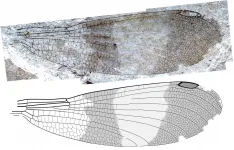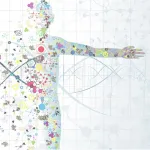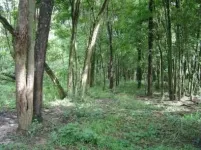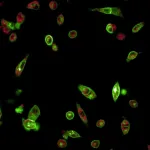Bearded seals are loud -- but not loud enough
Vocal threshold may hamper survival of this Arctic species
2021-02-24
(Press-News.org) Ithaca, NY-- During mating season, male bearded seals make loud calls to attract a mate--even their "quiet" call could still be as ear-rattling as a chainsaw. Bearded seals have to be loud to be heard over the cacophony of their equally loud brethren. And, increasingly, the noise humans make is adding to the underwater din and could have serious consequences. A study conducted by the Cornell Lab of Ornithology's Center for Conservation Bioacoustics (CCB) aims to understand how resilient bearded seals can be to changes in ambient underwater noise. The results are published in Proceedings of the Royal Society: Biological Science.
"We wanted to know whether bearded seals would call louder when their habitat grew noisy from natural sound sources," says CCB postdoctoral research associate Michelle Fournet who led the study. "The goal was to determine if there was a 'noise threshold' beyond which seals either couldn't-or wouldn't-call any louder in order to heard. By identifying this naturally occurring threshold, we can make conservation recommendations about how loud is too loud for human activities.'
From spring through early summer, the under-ice habitat near Utqiagvik, Alaska, is flooded with the vocalizations of male bearded seals--a sound that can be best described as "otherworldly." These elaborate vocalizations are essential for bearded seal reproduction, but in the rapidly changing Arctic soundscape, where noise from industrial activities is predicted to dramatically increase in the next 15 years, bearded seals may need to adjust their calling behavior if they are going to be heard above the noise generated by ships and commercial activities. But the bearded seals can only do so much.
Fournet and colleagues listened to thousands of recorded bearded seal vocalizations from Arctic Alaska spanning a two-year period. Each call was carefully measured and compared to the concurrent ambient noise conditions. What they found is that bearded seals do call louder as their underwater acoustic habitat gets noisier, but there is an upper limit to this behavior. As expected, when ambient noise gets too high, bearded seals are no longer able to compensate in order to be heard. As a result, as ambient noise conditions increase, the distance over which individuals can be detected goes down.
"Given that these are reproductive calls, it is likely that the seals are already calling as close to as loudly as possible-the males very much want to be heard by the females," Fournet says. "So, it is unsurprising that there is an upper limit. I'm grateful that we have been able to identify that limit so we can make responsible management choices moving forward."
While this work has intrinsic conservation value, a major impetus for pursuing this research is the value of bearded seals-or ugruk in the Inupiaq language-to Alaska Native communities in the high Arctic. Bearded seals are at the center of subsistence and cultural activities in Inupiaq communities. Threats to bearded seals are by extension threats to the communities that rely on them.
"This work never would have happened without the insight and guidance of Arctic communities," Fournet says. "It was their energy that led the Cornell Lab to place hydrophones in the water. It is our job to continue listening."
INFORMATION:
Reference:
Michelle E. H. Fournet, Margherita Silvestri, Christopher W. Clark, Holger Klinck, and Aaron N. Rice. Limited vocal compensation for elevated ambient noise in bearded seals: implications for an industrializing Arctic Ocean. Proceedings of the Royal Society B. February 2021.
[Attachments] See images for this press release:
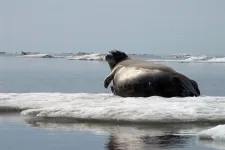
ELSE PRESS RELEASES FROM THIS DATE:
2021-02-24
Researchers at Stevens Institute of Technology have developed a new machine learning-powered platform, known as OC-SMART, that can process ocean color in satellite images 10 times faster than the world's leading platform. The work, which will be adopted by NASA, is one of the first machine learning-based platforms in ocean color analysis that can process both coastal and open ocean regions globally to reveal data on sea health and the impact of climate change.
The work, led by Knut Stamnes, a physics professor at Stevens, and spearheaded by Yongzhen Fan Ph.D. '16, a visiting physics scholar in Stamnes' lab, solves a 30-year-old problem in retrieving data from both coastal regions and open ocean areas. For decades, NASA's SeaDAS platform exceled at analyzing ocean color ...
2021-02-24
For more than 150 years, scientists have been incorrectly classifying a group of fossil insects as damselflies, the familiar cousins of dragonflies that flit around wetlands eating mosquitoes. While they are strikingly similar, these fossils have oddly shaped heads, which researchers have always attributed to distortion resulting from the fossilization process.
Now, however, a team of researchers led by Simon Fraser University (SFU) paleontologist Bruce Archibald has discovered they aren't damselflies at all, but represent a major new insect group closely related to them.
The findings, published today in Zootaxa, show that the distinctive shape of the insect's non-protruding, ...
2021-02-24
When people hear botulinum toxin, they often think one of two things: a cosmetic that makes frown lines disappear or a deadly poison.
But the "miracle poison," as it's also known, has been approved by the F.D.A. to treat a suite of maladies like chronic migraines, uncontrolled blinking, and certain muscle spasms. And now, a team of researchers from Harvard University and the Broad Institute have, for the first time, proved they could rapidly evolve the toxin in the laboratory to target a variety of different proteins, creating a suite of bespoke, super-selective ...
2021-02-24
A Brazilian study published (http://www.nature.com/articles/s41467-020-20217-w) in Nature Communications shows that human activities have directly or indirectly caused biodiversity and biomass losses in over 80% of the remaining Atlantic Rainforest fragments.
According to the authors, in terms of carbon storage, the biomass erosion corresponds to the destruction of 70,000 square kilometers (km²) of forest - almost 10 million soccer pitches - or USD 2.3 billion-USD 2.6 billion in carbon credits. "These figures have direct implications for mechanisms of climate change mitigation," they state in the article.
Atlantic Rainforest remnants ...
2021-02-24
DALLAS - Feb. 24, 2021 - Using machine learning tools to analyze hundreds of proteins, UT Southwestern researchers have identified a group of biomarkers in blood that could lead to an earlier diagnosis of children with autism spectrum disorder (ASD) and, in turn, more effective therapies sooner.
The identification of nine serum proteins that strongly predict ASD were reported in a study published today by PLOS ONE.
Earlier diagnosis, followed by prompt therapeutic support and intervention, could have a significant impact on the 1 in 59 children diagnosed with autism in the United States. Being able to identify children on the autism spectrum when they are toddlers could make a big difference, says Dwight German, Ph.D., professor of psychiatry at UT Southwestern ...
2021-02-24
For decades, climate change researchers and activists have used dramatic forecasts to attempt to influence public perception of the problem and as a call to action on climate change. These forecasts have frequently been for events that might be called "apocalyptic," because they predict cataclysmic events resulting from climate change.
In a new paper published in the International Journal of Global Warming, Carnegie Mellon University's David Rode and Paul Fischbeck argue that making such forecasts can be counterproductive. "Truly apocalyptic forecasts can only ever be observed in their failure--that is the world did not end as predicted," says Rode, adjunct research faculty with the Carnegie Mellon Electricity Industry Center, "and observing ...
2021-02-24
Parenthood leads to greater reductions in short-term research productivity for mothers across three disciplines than for fathers, largely explaining the publication gender gap between women and men in academia, according to an analysis of survey data from 3,064 tenure track faculty at PhD-granting universities in the U.S. and Canada. The findings suggest that policies designed to boost workplace flexibility for parents, including easily accessible lactation rooms and affordable childcare, may help to ease the impact of parenthood on mothers in academia, giving them more time for research. While a large body of previous research across academic fields has shown that men tend to publish more papers than women, the reasons for this have remained uncertain. ...
2021-02-24
Scientists have found that comparing the ratio of two immune molecules helped predict the likelihood of transplant rejection in 339 patients who received kidney transplants, the only curative treatment for late-stage kidney failure. Their results suggest that monitoring this ratio could help distinguish high-risk patients early on, before long-term organ rejection becomes inevitable, allowing clinicians to intervene accordingly with new treatments. Kidney transplants often grant immediate benefits to patients with end-stage kidney disease, but long-term outcomes are mixed, as 35% of transplant recipients lose their new kidney within ...
2021-02-24
Cancer cells can experience stress. They have to contend with attacks by the immune system or with anti-cancer therapeutics. If they attempt to colonize other tissues, they have to break away from the extracellular matrix, enter the bloodstream and survive during the travel through the body. Then exit and start building a new colony. The ability of cells to adapt their properties to face all the challenges they encounter is called plasticity. In epithelial solid tumors, including the very common lung, breast, colon and pancreatic cancers, tumor cells plasticity hijacks a cellular development process known as epithelial-mesenchymal transition (EMT).
EMT is commonly associated to kinases - enzymes that act like a switch, turning biochemical ...
2021-02-24
Targeted radiation is often used to study and treat diverse cancer types. A multidisciplinary research team based at the University of Chicago Medicine has recently focused on a type of cell that releases a protein that enhances resistance to cancer therapies and promotes tumor progression.
The study focused on Ter cells, which are extra medullary erythroid precursers that secrete the neuropeptide artemin. In the study, published February 24, 2020, in Science Translational Medicine, the researchers showed that local tumor radiotherapy, systemic immunotherapy or the combination of both treatments were able to deplete Ter cells in the spleen, reduce artemin production and limit tumor progression both in the locally irradiated tumors as well as outside ...
LAST 30 PRESS RELEASES:
[Press-News.org] Bearded seals are loud -- but not loud enough
Vocal threshold may hamper survival of this Arctic species

